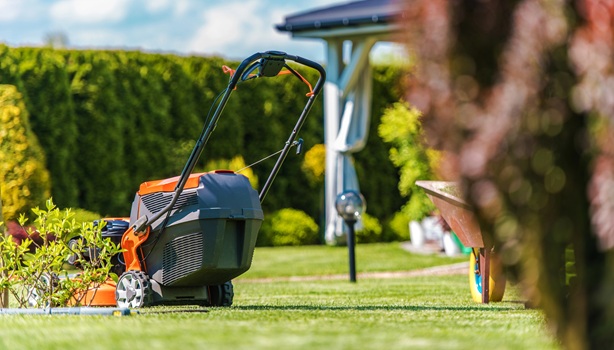
Starting your lawn care journey can feel like a big undertaking, but with the right steps, even beginners can enjoy a beautiful, thriving lawn. Whether you’re dealing with cool-season grasses like Kentucky Bluegrass and Fescue or warm-season favourites like Bermuda and Zoysia, good maintenance practices matter far more than expensive treatments or guesswork. By learning the fundamentals and applying them consistently, you’ll see stronger turf, fewer weeds, and better overall results.
If you’re ready to boost your curb appeal and enjoy a lush green space, here are 10 beginner-friendly lawn care tips that lay the groundwork for long-term success.
- 1. Identify Your Grass Type First
- 2. Lawn Care Starts With a Soil Test
- 3. Water the Right Way, Not Just More Often
- 4. Learn Proper Mowing and Lawn Care Techniques
- 5. Fertilize Based on Your Soil’s Needs
- 6. Aerate Heavy or Compacted Soil
- 7. Overseed to Keep Your Lawn Thick and Strong
- 8. Tackle Weeds Early and Strategically in Lawn Care
- 9. Keep an Eye Out for Pests and Lawn Diseases
- 10. Stay Consistent and Patient With Lawn Care
1. Identify Your Grass Type First
Every good lawn care in Conway SC begins with understanding your grass type. Different species have different care needs, growth habits, and seasonal strengths. Cool-season grasses such as Kentucky bluegrass, perennial ryegrass, and tall fescue grow best in northern climates. Meanwhile, warm-season grasses like Bermuda, Zoysia, and centipede thrive in southern regions where summers are longer and hotter.
Knowing your grass type helps you mow at the right height, fertilize at the right time, and water correctly year-round. If you’re unsure, bring a sample to your local extension office or use online guides with photos for reference.
2. Lawn Care Starts With a Soil Test
Before investing in fertilizers or treatments, test your soil. A simple test can reveal pH levels and nutrient deficiencies that may be hindering growth. Most turf grasses perform best when the soil pH is between 6.0 and 7.0.
When your soil is overly acidic, lime helps raise the pH. When it’s too alkaline, elemental sulfur may be needed to lower it. Understanding your soil allows you to make smarter fertilizer choices and avoid waste or runoff that harms nearby plants and water sources. For new homeowners in Conway SC especially, this is a critical first step in any lawn care plan.
3. Water the Right Way, Not Just More Often
Many beginners overwater, thinking more is always better. However, proper watering habits are key to healthy turf. Most lawns need about 1 to 1.5 inches of water per week, from rainfall or irrigation combined.
The best time to water is early in the morning, before 9 a.m. This allows moisture to soak in before the sun gets too strong and reduces the risk of fungal issues. Focus on deep, infrequent watering instead of shallow daily sprinkling. This trains roots to grow deeper and makes grass more resilient in dry weather.
4. Learn Proper Mowing and Lawn Care Techniques
Your mower can either help your lawn thrive or hold it back, depending on how it’s used. Always mow with sharp blades and avoid cutting more than one-third of the grass blade at a time. Cutting too short (known as scalping) weakens your lawn and leaves it vulnerable to stress and weeds.
Cool-season grasses typically perform best when mowed between 2.5 and 4 inches, while warm-season grasses prefer 1 to 2.5 inches. Leaving grass clippings on the lawn can also return nutrients to the soil, reducing the need for fertilizer.
5. Fertilize Based on Your Soil’s Needs

Lawn care in Conway SC
It’s tempting to buy an all-purpose fertilizer and hope for the best. But the most effective lawn care involves tailoring your fertilizer application to your lawn’s specific needs. Use the recommendations from your soil test to guide your choices.
Cool-season lawns benefit from fertilizing in early spring and autumn, while warm-season lawns respond well to late spring and summer feedings. Look for slow-release nitrogen formulas that feed your lawn gradually without causing sudden growth spurts that invite pests and disease.
6. Aerate Heavy or Compacted Soil
Soil that’s too compact doesn’t let water, oxygen, or nutrients reach your grass’s roots. This is common in areas with high foot traffic, clay-heavy soils, or where heavy equipment has been used.
Core aeration involves removing small plugs of soil from the lawn, which relieves compaction and encourages better root development. Fall is often the best time for this in cool-season lawns, while spring works better for warm-season grasses.
7. Overseed to Keep Your Lawn Thick and Strong
Overseeding helps fill in bare spots and thicken your lawn, making it more resistant to weeds and disease. Cool-season lawns should be overseeded in late summer or early autumn for the best germination. Warm-season lawns are typically established using sod or plugs, although some varieties like Bermuda can be seeded in late spring.
Be sure to create good seed-to-soil contact by raking lightly or using a slit seeder. Keep the area consistently moist for several weeks to encourage germination and establishment.
8. Tackle Weeds Early and Strategically in Lawn Care
Even healthy lawns can get the occasional weed, but dense turf makes it harder for them to spread. A pre-emergent herbicide can stop weed seeds from germinating, especially crabgrass and other common invaders. Timing is important—apply when soil temperatures reach around 50–55°F, just before germination begins.
Spot-treat visible weeds with a post-emergent herbicide, being careful not to overapply or damage nearby grass. For widespread issues, a lawn care expert in Conway SC can help determine the right treatment.
9. Keep an Eye Out for Pests and Lawn Diseases
Heat, humidity, and poor maintenance can create the perfect storm for lawn pests and diseases. Watch for signs of trouble like thinning patches, discoloration, or strange patterns in your grass. Common diseases include brown patch and red thread, while insects like grubs and chinch bugs can cause root damage.
Keeping your lawn well-aerated, properly fertilized, and mowed at the correct height can go a long way in preventing these issues. However, if symptoms appear, treat them early to avoid permanent damage.
10. Stay Consistent and Patient With Lawn Care
A common mistake new homeowners make is expecting overnight results. Even with perfect practices, lawns need time to respond and recover. Weather, soil conditions, and grass variety all influence how fast improvements appear.
The most important part of lawn care is consistency. Sticking to a schedule for mowing, watering, fertilizing, and monitoring keeps your lawn on track. Track what works (and what doesn’t), and adjust your plan as your grass matures.
If managing all of this feels overwhelming, Conway Lawn Care Service can assist with seasonal lawn care tailored to your grass type, soil condition, and goals. Their expert team helps you avoid costly mistakes and achieve greener results with less stress.
Call Conway Lawn Care Service now to book your first lawn care consultation and get a custom plan that works for your property, schedule, and turf goals. Your best lawn is just a few smart choices away.
Like our Facebook page for more information.
Conway Lawn Care Service
Conway, SC 29526
843-602-9872
http://conwaylawncareservices.com
Areas Served: Carolina Forest, Myrtle Beach, North Myrtle Beach, Conway, Surfside Beach, Forestbrook
No comments:
Post a Comment